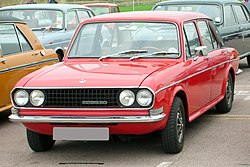This article needs additional citations for verification .(December 2009) |
| Austin Apache | |
|---|---|
 1976 Austin Apache | |
| Overview | |
| Manufacturer | Leykor (British Leyland) Authi |
| Also called | Austin Victoria (Spain) |
| Production | 1971–1978 |
| Assembly | South Africa: Cape Town (Leykor) Spain: Pamplona (Authi) |
| Designer | Giovanni Michelotti Alec Issigonis |
| Body and chassis | |
| Class | Compact |
| Body style | 4-door saloon |
| Layout | FF layout |
| Related | BMC ADO16 |
| Powertrain | |
| Engine | 1,275 cc A-series I4 |
| Dimensions | |
| Wheelbase | 2,370 mm (93 in) [1] |
| Length | 4,030 mm (159 in) [1] |
| Width | 1,530 mm (60 in) [1] |
The Austin Apache is a small family car that was produced by Leykor between November 1971 and 1978. [2] The Apache was the last BMC ADO16 car to be produced. The Spanish manufacturer Authi also built a version of the car, called the Austin Victoria, at its Pamplona plant between 1972 and 1975.


